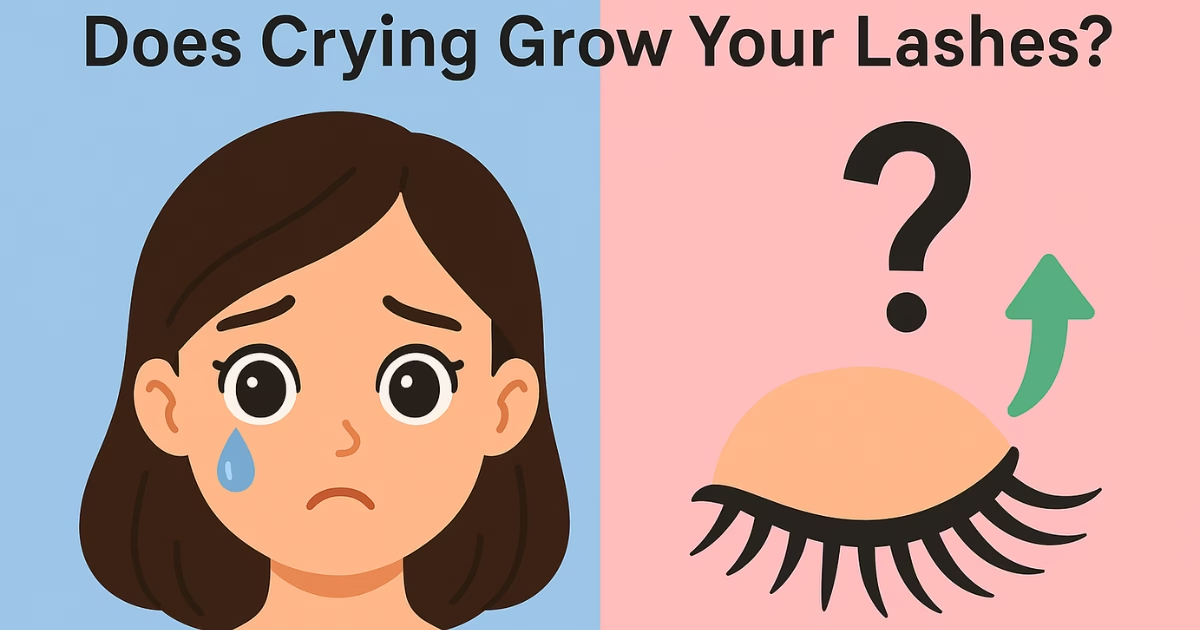Have you ever found yourself wondering, does crying grow your lashes? It’s a question that often pops up in beauty conversations and social media chats. Many believe that shedding tears could somehow nourish and lengthen eyelashes, creating a natural beauty boost after an emotional moment. But how much of this idea is fact, and how much is just a hopeful myth? Eyelash growth is a fascinating topic that combines biology, beauty trends, and a bit of wishful thinking. In this article, we’ll dig deep into the truth behind whether crying can actually impact your lash length. We’ll also uncover what really helps lashes grow and which myths you should ignore. Whether you’re a beauty enthusiast or simply curious, this guide will reveal everything you need to know about does crying grow your lashes and how to truly care for your delicate lashes.
Does Crying Grow Your Lashes? (Full Explanation)
The idea that crying might make your lashes grow has been floating around for years. Some people claim their lashes look fuller or longer after a good cry, leading to the belief that tears have special properties that nourish hair growth. But when it comes to the science behind it, the answer is clear: crying does not actually cause your lashes to grow.
What happens when you cry is mainly visual. The combination of swollen eyelids, damp lashes, and emotional flushing can make your eyelashes appear more prominent temporarily. The extra moisture from tears might cause lashes to clump together, giving the illusion of thickness or length. However, no scientific research supports the idea that the act of crying stimulates hair follicles or speeds up the eyelash growth cycle. While it’s a comforting thought, the truth is that real eyelash growth depends on factors like genetics, health, and proper care — not emotions.
How Eyelashes Naturally Grow
Eyelash growth is a natural process that follows the same biological principles as the growth of hair on your scalp. Each eyelash goes through a growth cycle that includes three main phases: Anagen, Catagen, and Telogen. Understanding these phases can help explain how lashes grow and why they don’t grow indefinitely.
- Anagen (Growth Phase): This is the active phase where the lash is growing. It typically lasts between 30 and 45 days. The length of this phase is determined by genetics, meaning some people have longer anagen phases than others. During this phase, the lash is growing from the follicle, fed by blood vessels that deliver nutrients.
- Catagen (Transitional Phase): This short phase lasts about 2-3 weeks. During this period, the lash stops growing and detaches from the blood supply. It’s essentially the resting phase before the lash prepares to shed.
- Telogen (Resting Phase): The longest phase of the cycle, lasting up to several months. During this time, the lash doesn’t grow and is simply “resting” before it falls out and is replaced by a new lash.
A variety of factors influence the health of your lashes during these phases, such as genetics, diet, and environmental factors. While crying doesn’t influence this cycle, taking proper care of your lashes through good nutrition and gentle handling can help promote stronger, healthier lashes.
What Happens to Your Eyes and Lashes When You Cry
When you cry, several things happen to your eyes and lashes. Tears, which are composed of water, oil, mucus, and antibodies, act as a natural cleanser for your eyes. They help to flush out irritants and soothe the eye area. However, the effects of crying on lashes are primarily visual and temporary, not biological growth.
The most noticeable change is the moisture that coats your lashes. Tears can make your lashes appear darker and clump together, giving the illusion of thickness. The emotional response from crying may also cause the eyelids to swell slightly, which can make the lashes look more prominent. But while your lashes may seem fuller or more defined during this time, it’s not due to any actual growth.
Moreover, frequent rubbing of your eyes during or after crying can lead to damage or breakage of delicate lashes. To protect your lashes, it’s important to gently pat your eyes dry and avoid harsh rubbing.
The Myth vs The Scientific Truth
As much as we might wish for it to be true, crying does not grow your lashes. This popular myth is simply a misunderstanding of the way tears and lashes interact. While it’s true that crying causes temporary changes in the appearance of your lashes — such as making them clump together or appear thicker — this is not a sign of growth.
The growth of your lashes depends on a number of biological factors, including genetics, health, and proper eyelash care. Crying, in contrast, only causes temporary changes to the look of your lashes, not their actual length or thickness.
There are no scientific studies that support the idea that crying stimulates eyelash follicles to promote growth. Eyelash growth, like hair growth, follows a natural cycle that is largely determined by genetics and lifestyle factors, not emotional reactions.
Real Ways to Boost Eyelash Growth Naturally
If you want longer, thicker lashes, the key lies in proper care and some scientifically-backed methods that actually help improve lash health. Here are some tips to help boost your eyelash growth naturally:
- Use Castor Oil: This oil has long been praised for its potential to moisturize and strengthen hair follicles. While it may not directly promote new lash growth, it can help keep lashes healthy and prevent breakage.
- Eat a Balanced Diet: Healthy lashes start from the inside. A diet rich in vitamins such as biotin, vitamin E, and omega-3 fatty acids can support lash health. Foods like eggs, nuts, and leafy greens are great sources of these nutrients.
- Avoid Mascara Damage: Constant use of mascara, especially waterproof formulas, can weaken your lashes over time. Be sure to remove makeup gently each night to prevent pulling or tugging at the lashes.
- Try Lash Serums: Some lash serums, which contain ingredients like bimatoprost, have been shown to promote eyelash growth in clinical studies. These products are typically applied along the upper lash line and can provide noticeable results over time.
- Be Gentle: Avoid rubbing your eyes or pulling at your lashes when you remove makeup. Always use a soft touch when cleaning your eyes to prevent unnecessary lash loss or breakage.
By taking these steps, you can nurture your eyelashes and encourage their natural growth cycle, all without relying on the myth that crying can make them grow.
Common Eyelash Growth Myths You Should Ignore
As with many beauty topics, there are several myths surrounding eyelash growth that simply aren’t true. Here are a few common ones you should ignore:
- Crying Makes Lashes Grow: As we’ve discussed, crying doesn’t stimulate lash growth. While tears may temporarily change the appearance of your lashes, they don’t cause them to grow.
- Trimming Lashes Makes Them Grow Faster: Trimming or cutting your lashes does not make them grow faster or longer. Just like cutting hair doesn’t make it grow quicker, trimming your lashes won’t speed up their natural cycle.
- Vaseline Guarantees Lash Growth: While Vaseline can help condition lashes, it doesn’t promote growth. It may help prevent lashes from breaking, but it won’t lengthen them.
- Lash Extensions Can Make Natural Lashes Grow: Lash extensions can provide a fuller look, but they don’t encourage natural growth. In fact, they can sometimes damage your lashes if applied improperly.
Avoiding these myths and focusing on scientifically backed methods will give you the best chance at achieving long, healthy lashes.
Also read: Does Crying Make Your Eyelashes Fall Out: A Complete Guide
FAQs About Crying and Eyelash Growth
Can crying too much damage your lashes?
Crying itself doesn’t damage lashes, but excessive rubbing or harsh wiping of tears can cause breakage or fallout. Be gentle when wiping your eyes to avoid this.
How can I make my eyelashes grow faster naturally?
Focus on a healthy diet, proper lash care, and using products like castor oil or lash serums that promote healthy lashes. Avoid rubbing your eyes and remove makeup gently.
Does crying hydrate your lashes?
Crying temporarily moistens the lashes, but this doesn’t contribute to long-term hydration or growth. It’s more about appearance rather than actual nourishment.
Are emotional tears different from regular tears?
Emotional tears have a different chemical composition than reflex tears (the kind you get from cutting onions). However, neither type of tear has an effect on eyelash growth.
Conclusion
While the myth that crying grows your lashes is an appealing one, the truth is that crying only affects the appearance of your lashes temporarily. The growth of your eyelashes depends on your genetic makeup, health, and proper care. To truly achieve longer, healthier lashes, focus on nutrition, gentle cleansing, and products designed to nourish and strengthen your lashes.
By understanding the science behind lash growth and debunking the common myths, you can give your eyelashes the care they deserve and help them reach their full potential. So, while it might be tempting to hope for a lash boost after a good cry, remember that real lash growth requires proper care and patience.

Hi, I’m Shafy Ali – a curious mind and passionate writer at Celiac Magazine. I cover a little bit of everything, from everyday tips and how-tos to deeper dives into topics that spark conversation. I enjoy turning research into readable, relatable content that informs and inspires. Whatever the subject, I aim to keep it clear, engaging, and genuinely useful.

